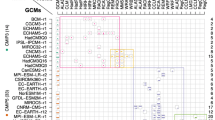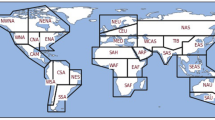Abstract
Regional and seasonal temperature and precipitation over land are compared across two generations of global climate model ensembles, specifically, CMIP5 and CMIP3, through historical twentieth century skills and multi-model agreement, and twenty first century projections. A suite of diagnostic and performance metrics, ranging from spatial bias or model-consensus maps and aggregate time series plots, to measures of equivalence between probability density functions and Taylor diagrams, are used for the intercomparisons. Pairwise and multi-model ensemble comparisons were performed for 11 models, which were selected based on data availability and resolutions. Results suggest little change in the central tendency or variability or uncertainty of historical skills or consensus across the two generations of models. However, there are regions and seasons, at different levels of aggregation, where significant changes, performance improvements, and even degradation in skills, are suggested. The insights may provide directions for further improvements in next generations of climate models, and in the meantime, help inform adaptation and policy.
























Similar content being viewed by others
References
Adler RF, Huffman GJ, Chang A, Ferraro R, Xie P, Janowiak J, Rudolf B, Schneider U, Curtis S, Bolvin D, Gruber A, Susskind J, Arkin P (2003) The version-2 global precipitation climatology project (GPCP) monthly precipitation analysis (1979-present). J Hydrometeorol 4:1147–1167
Adler RF, Gu G, Huffman GJ (2012) Estimating climatological bias errors for the global precipitation climatology project (GPCP). J Appl Meteor Climatol 51:84–99
Blázquez J, Nuñez MN (2013) Analysis of uncertainties in future climate projections for South America: comparison of WCRP-CMIP3 and WCRP-CMIP5 models. Clim Dyn 41:1039–1056
Brands S, Herrera S, Fernández J, Gutiérrez JM (2013) How well do CMIP5 Earth System Models simulate present climate conditions in Europe and Africa? Clim Dyn 41:803–817
Branstator G, Teng H (2012) Potential impact of initialization on decadal predictions as assessed for CMIP5 models. Geophys Res Lett 39:L12703. doi:10.1029/2012GL051974
Brohan P, Kennedy JJ, Harris I, Tett SFB, Jones PD (2006) Uncertainty estimates in regional and global observed temperature changes: a new data set from 1850. J Geophys Res 111:D12106. doi:10.1029/2005JD006548
Cattiaux J, Douville H, Peings Y (2013) European temperatures in CMIP5: origins of present-day biases and future uncertainties. Clim Dyn 41:2889–2907
Deser C, Knutti R, Solomon S, Phillips AS (2012) Communication of the role of natural variability in future North American climate. Nat Clim Chang 2:775–779
Dessai S, Lu X, Hulme M (2005) Limited sensitivity analysis of regional climate change probabilities for the twenty first century. J Geophy Res 110:D19108. doi:10.1029/2005JD005919
Giorgi F, Francisco R (2000) Uncertainties in regional climate change prediction: a regional analysis of ensemble simulations with the HADCM2 coupled AOGCM. Clim Dyn 16:169–182
Gleckler PJ, Taylor KE, Doutriaux C (2008) Performance metrics for climate models. J Geophys Res 113:D06104. doi:10.1029/2007JD008972
Hulme M, Pielke R Jr, Dessai S (2009) Keeping prediction in perspective. Nat Rep Clim Chang. doi:10.1038/climate.2009.110
Joetzjer E, Douville H, Delire C, Ciais P (2013) Present-day and future Amazonian precipitation in global climate models: CMIP5 versus CMIP3. Clim Dyn 41:2921–2936
Kalnay EM et al (1996) The NCEP/NCAR 40-year reanalysis project. Bull Am Meteor Soc 77:437–471
Kanamitsu M et al (2002) NCEP-DOE AMIP-II Reanalysis (R-2). Bull Am Meteor Soc 83:1631–1643
Kao SC, Ganguly A (2011) Intensity, duration, frequency of precipitation extremes under twenty first century warming scenarios. J Geophy Res 116:D16119. doi:10.1029/2010JD015529
Kharin VV, Zweris FW (2002) Climate predictions with multimodel ensembles. J Clim 15:793–799. doi:10.1175/1520-0442(2002
Kharin VV, Zwiers FW, Zhang X, Hegrel GC (2007) Changes in temperature and precipitation extremes in the IPCC ensemble of global coupled model simulations. J Clim 20:1419–1444. doi:10.1175/JCLI4066.1
Knutti R, Sedlacek J (2012) Robustness and uncertainties in the new CMIP5 climate model projections. Nat Clim Chang 3:369–373
Knutti R, Abramowitz G, Collins M et al (2010) Good practice guidance paper on assessing and combining multi model climate projections. In: meeting report of the intergovernmental panel on climate change expert meeting on assessing and combining multi model climate projections [Stocker, T.F., D. Qin, G.-K. Plattner, M. Tignor, and P. M. Midgley (eds.)]. IPCC Working Group I Technical Support Unit, University of Bern, Bern, Switzerland
Kodra E, Steinhaeuser K, Ganguly A (2011) Persisting cold extremes under twenty first century warming scanarios. Geophys Res Lett 38:L08705. doi:10.1029/2011GL047103
Kug J-S, Ham Y-G, Lee J-Y, Jin F–F (2012) Improved simulation of two types of El-Nino in CMIP5 models. Environ Res Lett 7:034002. doi:10.1088/1748-9326/7/3/034002
Liu C, Allan RP, Huffman GJ (2012) Co-variation of temperature and precipitation in CMIP5 models and satellite observations. Geophys Res Lett 39:L13803. doi:10.1029/2012GL052093
Maslin M, Austin P (2012) Uncertainty: climate models at their limit? Nature 486:183–184
Meehl GA, Goddard L, Murphy J et al (2009) Decadal prediction: can it be skillful? Bull Am Meteor Soc 90:1467–1485. doi:10.1175/2009BAMS2778.1
Monerie PA, Fontaine B, Roucou P (2012) Expected future changes in the African monsoon between 2030 and 2070 using some CMIP3 and CMIP5 models under a medium-low RCP scenario. J Geophys Res. doi:10.1029/2012JD017510
Moss R, Babiker M, Brinkman S et al (2008) Towards new scenarios for analysis of emissions, climate change, impacts, and response Strategies. Intergovernmental Panel on Climate Change. Geneva: 132 pp
Moss RH, Edmonds JA, Hibbard KA et al (2010) The next generation of scenarios for climate change research and assessment. Nature 463:747–756
Perkins SE, Pitman AJ, Holbrook NJ, Mcaneney J (2007) Evaluation of the AR4 climate models’ simulated daily maximum temperature, minimum temperature, and precipitation over Australia using probability density functions. J Clim 20:4356–4376
Reichler T, Kim J (2008) How well do coupled models simulate today's climate? Bull Am Meteor Soc 89:303–311
Rogelj J, Meinshausen M, Knutti R (2012) Global warming under old and new scenarios using IPCC climate sensitivity range estimates. Nat Clim Chang 2:248–253. doi:10.1038/nclimate1385
Rupp D, Abatzoglou J, Hegewisch K, Mote P (2013) Evaluation of CMIP5 twentieth century climate simulations for the Pacific Northwest USA. J Geophys Res 118:10884–10906. doi:10.1002/jgrd.50843
Sanderson BM, Knutti R (2012) On the interpretation of constrained climate model ensembles. Geophys Res Lett 39:L16708. doi:10.1029/2012GL052665
Santer BD, Taylor KE, Glecker PJ et al (2009) Incorporating model quality information in climate change detection and attribution studies. Proc Natl Acad Sci 106:14778–14783. doi:10.1073/pnas.0901736106
IPCC Special Report on Emissions Scenarios (eds Nakicenovic, N. & Swart, R.) (Cambridge Univ. Press, 2007)
Shukla J, Hagedorn R, Hoskins B et al (2009) Revolution in climate prediction is both necessary and possible: a declaration at the world modelling summit for climate prediction. Bull Am Meteor Soc 2:175–178. doi:10.1175/2008BAMS2759
Sillmann J, Kharin VV, Zweris FW, Zhang X, Bronaugh D (2013a) Climate extreme indices in the CMIP5 multimodel ensemble: part 1. Model evaluation in the present climate. J Geophys Res Atmos 118:1–18. doi:10.1002/jgrd.50203
Sillmann J, Kharin VV, Zweris FW, Zhang X, Bronaugh D (2013b) Climate extreme indices in the CMIP5 multimodel ensemble: part 2. Future climate projections. J Geophys Res Atmos 118:2473–2493. doi:10.1002/jgrd.50188
Sperber KR, Annamalai H, Kang I-S, Kitoh A, Moise A, Turner A, Wang B, Zhou T (2013) The Asian summer monsoon: an intercomparison of CMIP5 vs. CMIP3 simulations of the late 20th century. Clim Dyn 41:2711–2744
Taylor KE (2001) Summarizing multiple aspects of model performance in a single diagram. J Geophys Res 106:7183–7192
Taylor KE, Stouffer RJ, Meehl GA (2011a) A summary of the CMIP5 experiment design. (Program for Climate Model Diagnosis and Intercomparison (PCMDI), 2011); available online at http://cmip-pcmdi.llnl.gov/cmip5/docs/Taylor_CMIP5_design.pdf
Taylor KE, Balaji V, Hankin S, Juckes M, Lawrence B, Pascoe S (2011b) CMIP5 Data Reference Syntax (DRS) and Controlled Vocabularies (Program for Climate Model Diagnosis and Intercomparison (PCMDI); available online at http://cmip-pcmdi.llnl.gov/cmip5/docs/cmip5_data_reference_syntax.pdf
Taylor KE, Stouffer RJ, Meehl GA (2012) An overview of CMIP5 and the experimental design. Bull Am Meteor Soc 93:485–498. doi:10.1175/BAMS-D-11-00094.1
Tebaldi C, Knutti R (2007) The use of the multimodel ensemble in probabilistic climate projections. Philos Trans R Soc 365:2053–2075
Wilks, DS (2011) Statistical methods in the atmospheric sciences. Academic Press, 704 pp
Acknowledgments
The work was funded by the United States (US) National Science Foundation (NSF) Expeditions in Computing Grant # 1029711. The US Nuclear Regulatory Commission and Northeastern University provided partial funding. The climate model datasets were obtained from the PCMDI archive of the US Department of Energy at LLNL.
Author information
Authors and Affiliations
Corresponding author
Rights and permissions
About this article
Cite this article
Kumar, D., Kodra, E. & Ganguly, A.R. Regional and seasonal intercomparison of CMIP3 and CMIP5 climate model ensembles for temperature and precipitation. Clim Dyn 43, 2491–2518 (2014). https://doi.org/10.1007/s00382-014-2070-3
Received:
Accepted:
Published:
Issue Date:
DOI: https://doi.org/10.1007/s00382-014-2070-3




